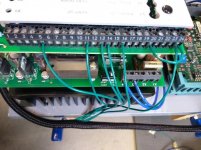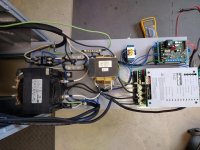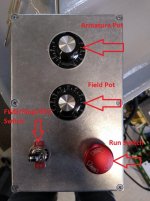Now that I have replaced the spindle in the 1990 10 ee I need to start on the electronics. Is the a parts list or diagram for this conversion?
It's pretty informal. The "basics" are in this very thread, basically "simplified" after (at least) five readings (each) of the SSD manuals! See footnote.
.. but each of us then, since, (and the several who went before, write-up or not..) have never been 100% identical as to choice of boost transformer (array), protective devices, potentiometers used, "ripple filter" choke...
Even Mark's and mine - done as a joint effort with a short ton of out-of-band emails - share the basic DC Drive "commissioning" option settings - which might seem odd, given I'm using the 3 HP "Large Frame" Reliance while he has the 5 HP GE KineMatic...
.. but we made different potentiometer, control switch/relay, fuse/circuit breaker, transformer, and choke choices.
"By the book" (Parker-SSD manual...) as to such goods needed...
And then..
The two most crucial parameters to satisfy for success are:
(A) Enough AC boost into the SSD. 320 to 350 VAC is a good target, and at 5 to 7 KVA.
Anything less, stability/load regulation suffers, even if not asking for full power.
(B) Enough ripple-filter in series on the DC output as to both Amps and inductance.
-- The Hammond is 20 Milli-not-Micro Henry @ 20 A.
-- The Lenze "swinging choke" I also use is 16A and variable inductance.
Anything MUCH less, audible noise at the final-drive motor goes up. Which is also audio frequency vibration (120 Hz, as a pronounced "growl" under hard accel or braking) in the drivetrain - potentially showing-up in the surface finish.
Which may not matter to most folk, but still...
When you have BOTH satisfied, you get a smooth running 10EE, FULL power (and a bit more on the 3 HP ones.. ~ 4.3 to 4.6 HP..) and a wider usable power-band than OEM.
(NB: I also use a filter choke on my FIELD supply, run at a 140 VDC max...)
The smooth LOW end is kinda awesome!
Do you NEED extended low-end? Well.. not for "collet running" & "carbides", no.
Then again, I'm an HSS/Cobalt // Stellite/Tantung-G guy. NOT carbides.
Annnnnd ALSO have several faceplates up to 11" and chucks 4" to 10"..as well as 5C, 2J, Rubberflex 9XX, Burnerd Multisize, ER and TG....
Keeping in mind that we don't run a 10EE at FULL load often if EVER, and that with such a short bed, even the final-drive motor gets a rest on the backhaul often enough Monarch didn't need to buy "Continuous Duty" motors....
If the 20 Amp, 20 mH Hammond choke (about $300, new) is hard to get into the budget, (only the 5 HP motor really needs that much Ampacity..) there are some "Rex" 17 mH @ 16A as show up, used, now and then.
My rare Lenze is even lesser Ampacity, but just fine for the "nominal 3 HP" motor, even pushed to a (calculated) max of around 4.6 HP.
NOTE: The Manual is complex because Shackelton Designed their "SSD" DC Drives as sort of "universal". They can be "Commissioned" or "option configured" to do almost anything that CAN be done with a single-phase DC drive.
What we do to run a 10EE is actually dirt-simple. But if Mark had not published this thread to pick-out the "meat", and if others had not also contributed, it would be all too easy to get sidetracked.
For a long time. "DAMHIKT!"









